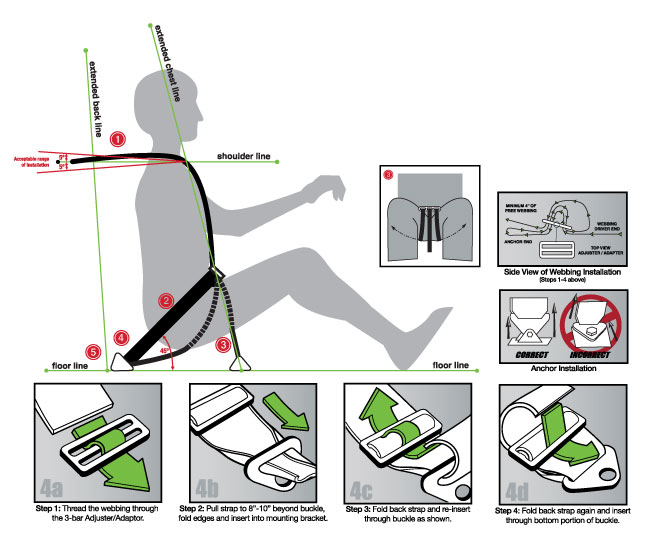|
Restraint System FAQ Click here to download a printable PDF of our Restraint Care and Installation Guide. PLEASE READ AND UNDERSTAND THIS INFORMATION BEFORE USING YOUR RESTRAINT SYSTEM To perform as designed, a Restraint System must be installed in strict compliance with the installation instructions. ANY deviation from approved installation may compromise the function, integrity and performance of the system. All Belts (Shoulder, lap, Anti-Sub) must be installed to allow even tension across the entire width of the webbing. Any installation that bunches, crimps, bends, reduces the width or creates uneven tension across the webbing is unacceptable installation. Particular attention must be made at mounting points, attachment points, and adjustment hardware to ensure symmetrical, even tension of the webbing when the user engages and tightens the system. All components of a Restraint System should be inspected regularly and prior to every use, including the webbing, stitching, release mechanism, adjusters, and anchor points. Check the webbing for fraying, abrasion, nicks, cuts or other damage. Check all stitching for broken or damaged threads. All hardware should operates smoothly as new and should be free of deformation. A simple, "common-sense" inspection indicating a system, "Doesn't look right," means it is probably not. REMOVE THE SYSTEM FROM SERVICE IMMEDIATELY. It is recommended that Restraint Systems be replaced at a minimum at least every two years. However, webbing that has been exposed to harmful solvents, chemicals, or acids, or prolonged exposure to outdoor elements, may need to be replaced sooner. A Restraint System that has been involved in an event such as a crash should also be replaced immediately. Consult your Sanctioning Body for their specific Restraint System requirements. Always use Restraint Systems adjusted correctly and users should never run a loosely adjusted harness. Installed webbing lengths should be kept as short as possible for best performance. Impact Restraint Installation Illustration 1. Shoulder Belts: The optimum location for the shoulder belt anchor is level with the shoulder line. Anchor shoulder belts a MAXIMUM of 5 degrees below and 5 degrees above the shoulder line. When installing shoulder belts in conjunction with a head and neck restraint system the anchor point for the shoulder belt must be in accordance with the head and neck restraint system manufacturer's recommendations. 2. Lap Belt: Lap Belt anchors should be located in a position that is slightly wider than the seat allowing the webbing to pull in a straight line to the mounting anchors. Do not allow the webbing to come in contact with any sharp edges that could cause abrasion. The angle formed by the Lap Belt and the vehicle floor, when the belt is being worn, should be approximately 45 degrees. 3. Anti-submarine Belts: 5-way or 6-way anti-sub belt(s) should be anchored behind the extended Chest Line. The extended Chest Line is a line drawn from the chest to the Lap Belt buckle continuing to the floor. On 7-way systems the outside anti-sub belts wrap around the inner to under thigh and exit the bottom seat. Anchor in the same position as the Lap Belt. 4. Webbing Installation: see diagram for proper installation. 5. Anchor Installation: Anchor hardware must be installed at an angle that is compatible with the load direction of the webbing. UNDER NO CIRCUMSTANCES ARE BOLTS INSTALLED THROUGH WEBBING ACCEPTABLE FOR INSTALLATION!! Always use a Restraint Systems that are adjusted correctly. Users should NEVER run a loosely adjusted harness! Installed webbing lengths should be kept as short as possible for best performance. Can you recertify my old Impact restraints?We do not "recertify" your restraint systems, but Impact's quality hardware and on-site manufacturing allow us to reweb your Impact Restraint Systems at a substantial savings over buying a new set of belts. Service includes inspection and webbing replacement with a new/current SFI 16.1 certification tag. This service is only available for Impact products, we will not work on other brands of belts. To start this process, please contact our sales department as you will need to get a Return Goods Authorization (RGA) number prior to sending your restraints in. One of our Sales members will provide you the address to ship your restraints to at that time. You can reach them at sales@ximpactusa.com or by calling (317) 852-3067. ** Please note: SFI Foundation will NOT allow 16.1 certification or recertification of Y-Type Shoulders. The below information and included links were taken direct from the SFI Foundation's website and are offered as an additional resource for Restraint System safety and information: Here is a downloadable PDF file an article regarding SFI and motorsports Seat Belts. And here is SFI's Guide to Seat Belt Installation. |